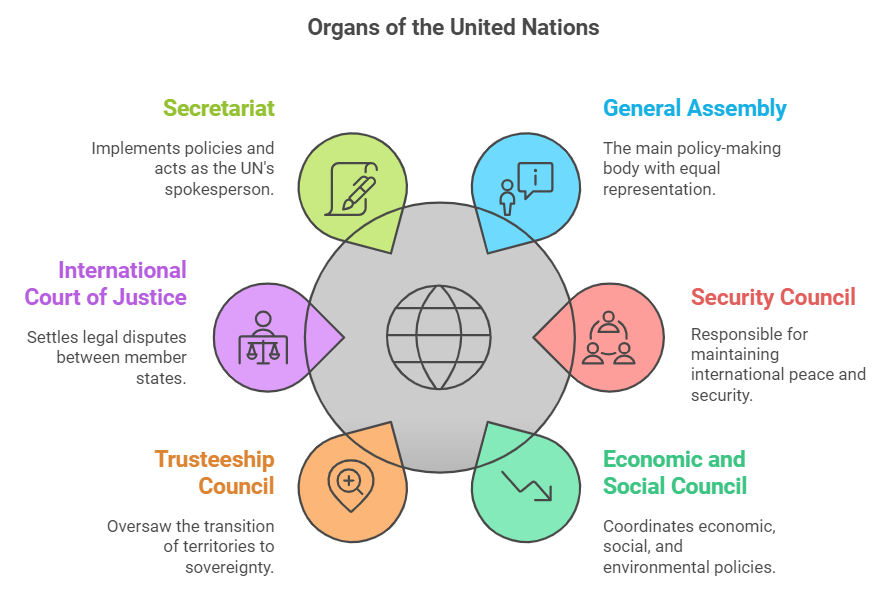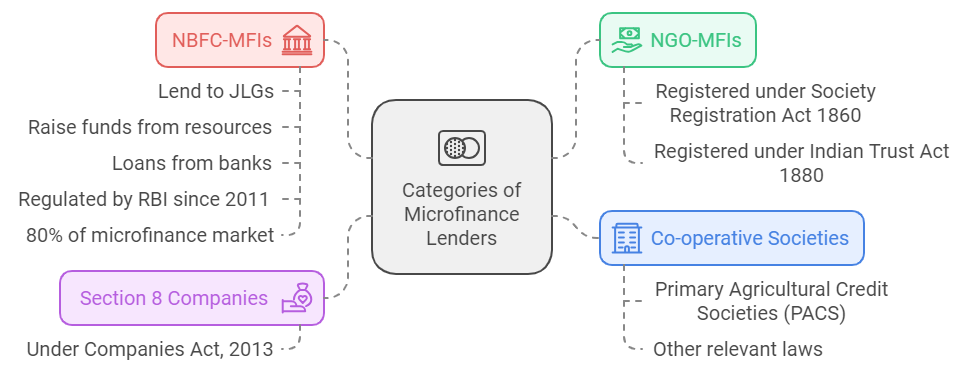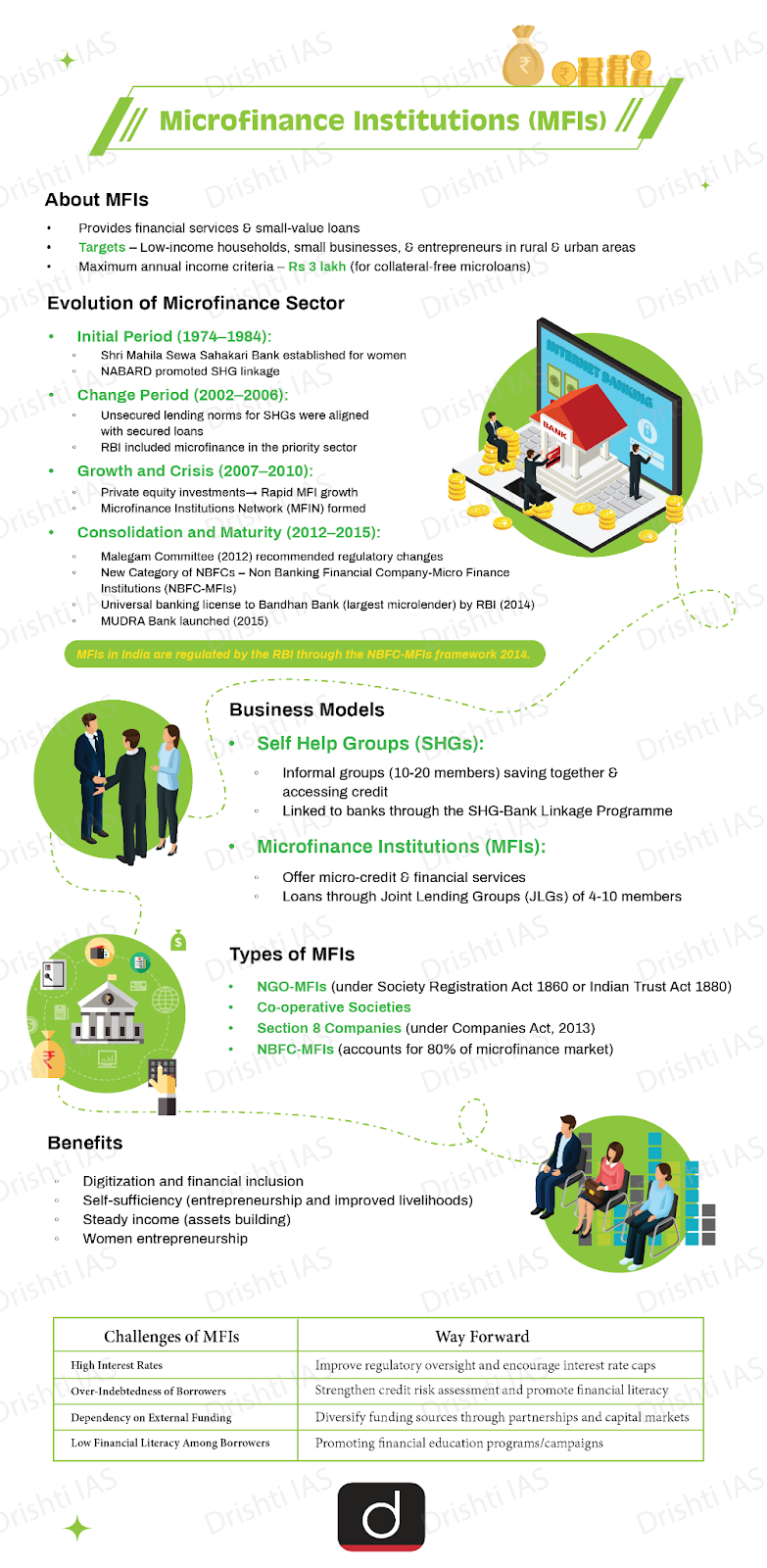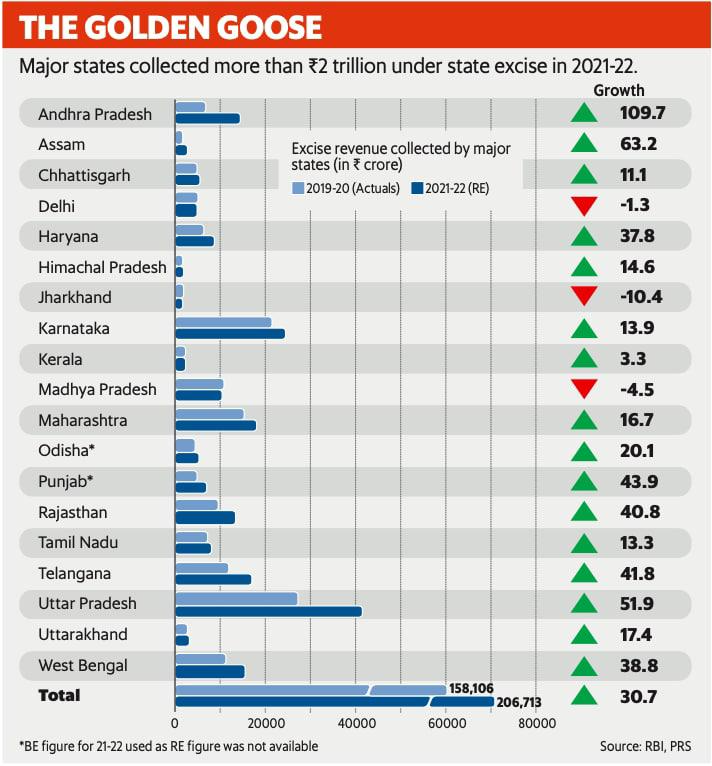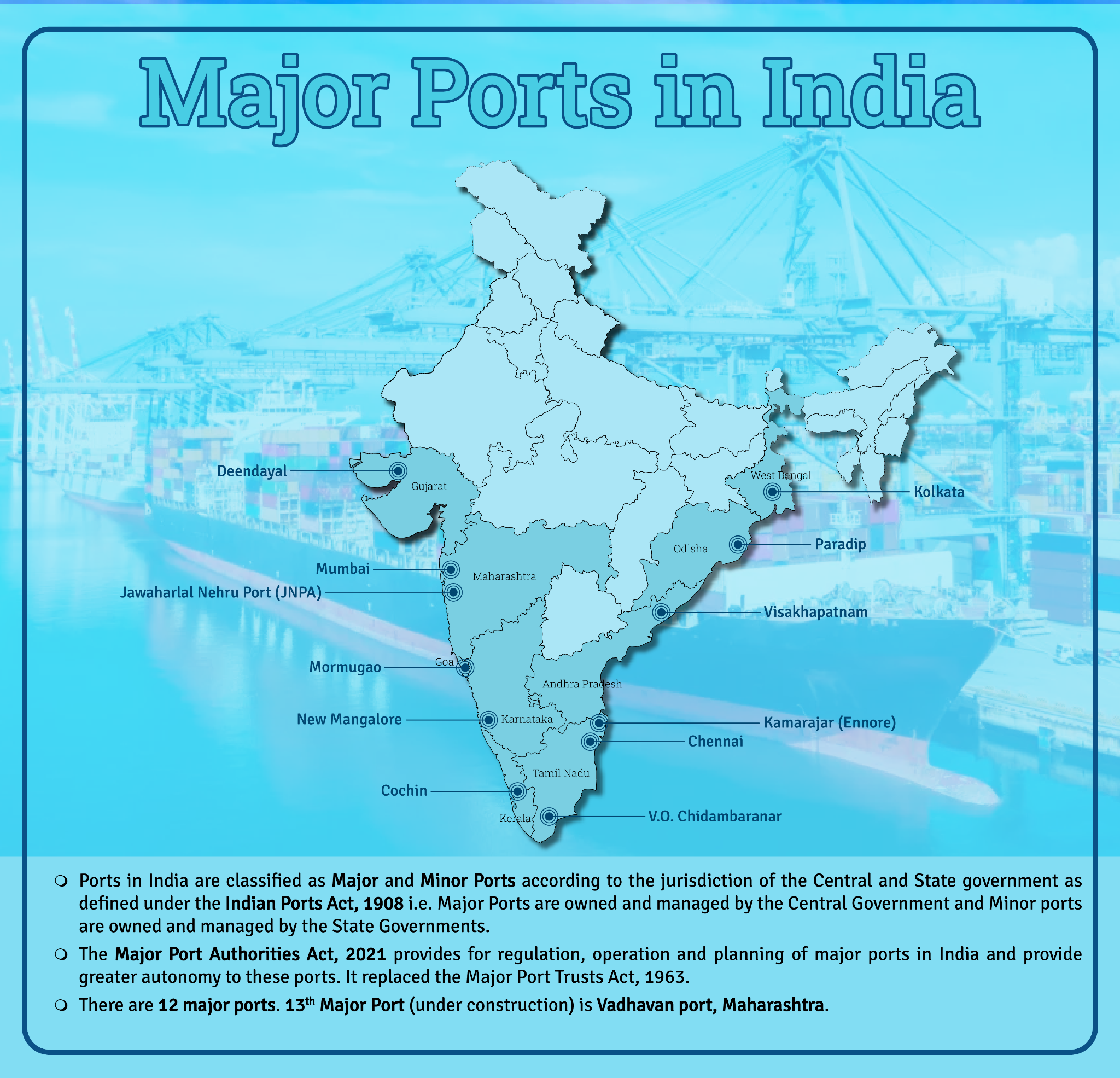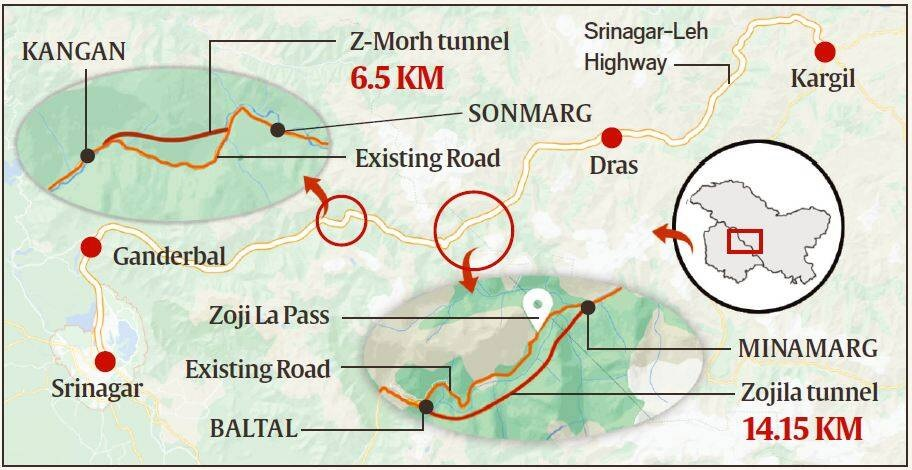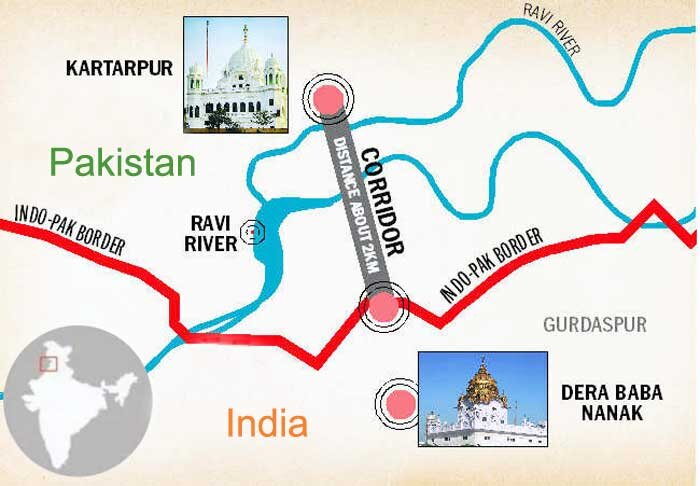United Nations Day 2024
For Prelims: United Nations Day, World War II, UN Charter, ECOSOC, UN General Assembly (UNGA), ICJ, Security Council
For Mains: Challenges Related to the UN and Proposals to Reform the UN
Why in News?
United Nations Day is celebrated each year on 24th October to mark the anniversary of the UN Charter coming into effect in 1945, following the end of World War II.
- The day aims to raise awareness about the goals and achievements of the international body.
What is the UN Charter?
- Background:
- It was signed on 26th June, 1945, in San Francisco at the end of the UN Conference on International Organisation and came into force on 24th October 1945.
- India is one of the founding members and ratified the UN charter on 30th October, 1945.
- The predecessor of the UN was the League of Nations, established in 1919, after World War I, under the Treaty of Versailles "to promote international cooperation and to achieve peace and security."
- It was signed on 26th June, 1945, in San Francisco at the end of the UN Conference on International Organisation and came into force on 24th October 1945.
- About:
- The Charter of the United Nations serves as the foundational document of the UN. It is an instrument of international law, and UN Member States are bound by it.
- It outlines key principles of international relations, including the equal rights of all countries and the ban on using force between nations.
- It has been amended three times since its incorporation – in 1963, 1965, and 1973.
- The Charter of the United Nations serves as the foundational document of the UN. It is an instrument of international law, and UN Member States are bound by it.
- Significance: The UN focuses on maintaining international peace and security, providing humanitarian assistance, protecting human rights, and upholding international law.
- It has been a key player in international cooperation, peace, and development for over 75 years.
What are the Different Organs of the UN?
- General Assembly: The UN General Assembly (UNGA) is the main policy-making organ of the Organisation. Comprising all Member States, it provides a unique forum for multilateral discussion of the full spectrum of international issues covered by the Charter of the UN.
- Each of the 193 Member States of the UN has an equal vote.
- The UN Security Council: The Security Council consists of 15 members.
- Five permanent members (China, France, Russian Federation, the United Kingdom, and the United States), and ten non-permanent members elected for two-year terms.
- India has been a non-permanent member of the UNSC eight times.
- UN Economic and Social Council: ECOSOC consists of 54 Members of the UN elected by the UNGA.
- It is the principal body for coordination, policy review, policy dialogue and recommendations on economic, social and environmental issues
- Trusteeship Council: One of the main organs of the UN, was established to supervise the administration of trust territories as they transitioned from colonies to sovereign nations.
- International Court of Justice: The ICJ is the only international court that settles disputes between the 193 UN Member States.
- The court can rule on two types of case: “contentious cases” are legal disputes between States and “advisory proceedings” are requests for advisory opinions on legal questions referred to it by UN organs and certain specialised agencies.
- Secretariat: The Secretary-General is appointed by the UNGA based on the Security Council's recommendation and serves as the chief administrative officer of the organisation.
Note:
- Five of the UN’s six principal organs namely, the UNGA, the UNSC, ECOSOC, the Trusteeship Council, and the UN Secretariat are based at UN Headquarters in New York.
- However, the ICJ is located in The Hague, Netherlands.
What are the Challenges Related to the UN?
- Power Alignments: The UN struggles with power imbalances between wealthy and developing nations, making it difficult to implement its goals. These alignments challenge the organisation's ability to act impartially and effectively address global issues.
- Security and Terrorism: The UN faces evolving security challenges, including terrorism and ideological conflicts. While addressing traditional threats, it must also tackle broader issues like human security, poverty, and disease, expanding its role in conflict prevention and global safety.
- Peace-keeping: Modern peacekeeping faces difficulties, particularly in internal conflicts where combatants often ignore UN neutrality. The challenge lies in transitioning from traditional peacekeeping to peace-observation, using rapidly deployable teams to address conflict zones effectively.
- Human Rights Challenges: The UN faces the challenge of establishing and reinforcing national human rights institutions, especially in post-conflict countries. Ensuring these systems adhere to international norms is crucial for long-term protection and promotion of human rights globally.
- Financial Constraints and Arrears: The UN grapples with financial instability due to delays in assessed contributions from member states, hindering its operational effectiveness and capacity to fulfill global commitments.
What are the Proposals to Reform the UN?
- Expanding Permanent Membership & Inclusive Representation:
- Expanding the number of permanent members beyond the P5 and addressing the veto power could result in a more representative and democratic Security Council.
- It would potentially give more countries, especially from underrepresented regions like Africa a voice in decision-making.
- Reducing Inefficiencies in Administrative Processes:
- Streamlining the UN's administrative procedures and reducing bureaucratic complexities can significantly improve its efficiency.
- India's Role in UN Reform:
- India has consistently demonstrated its commitment to global peace, security, and development through its participation in UN peacekeeping missions, humanitarian assistance programs, and contributions to various UN agencies.
- India seeks a permanent seat on the Security Council, emphasising that such a step would make the Council more representative and responsive to the needs of the 21st century.
|
Drishti Mains Question What are the main challenges faced by the UN in fulfilling its objectives? Analyze the proposed reforms to enhance its effectiveness. |
UPSC Civil Services Examination, Previous Year Question (PYQ)
Prelims
Q. With reference to the United Nations, consider the following statements: (2009)
- The Economic and Social Council (ECOSOC) of UN consists of 24 member States.
- It is elected by a 2/3rd majority of the General Assembly for a 3-year term.
Which of the statements given above is/are correct?
(a) 1 only
(b) 2 only
(c) Both 1 and 2
(d) Neither 1 nor 2
Ans: (b)
Q. Consider the following. (2011)
- Right to education
- Right to equal access to public service
- Right to food.
Which of the above is/are Human Right/Human Rights under “Universal Declaration of Human Rights”?
(a) 1 only
(b) 1 and 2 only
(c) 3 only
(d) 1, 2 and 3
Ans: (d)
Mains
Q. What are the main functions of the United Nations Economic and Social Council (ECOSOC)? Explain different functional commissions attached to it.150 words (2017)
Microfinance Institutions
For Prelims: Microfinance Institutions (MFIs), Financial Inclusion, SHGs, Co-operative Societies Primary Agricultural Credit Societies (PACS), Companies Act, 2013, NBFC-MFIs, Reserve Bank of India(RBI)
For Mains: Significance of microfinance institutions in financial inclusion, poverty alleviation, and sustainable economic development in India.
Why in News?
Recently, the Financial Services Secretary, while highlighting the crucial role of microfinance institutions (MFIs) in fostering financial inclusion, emphasised that they must avoid reckless lending despite their role in promoting financial inclusion.
Note:
- Many MFIs are under scrutiny for excessive interest rates (averaging around 24% per annum) and high processing fees, with findings of non-compliance in assessing borrowers' income and repayment capacities. A report by Sa-Dhan indicates minor interest rate reductions won’t significantly impact repayment amounts for low-income households.
What are Microfinance Institutions?
- About: MFIs are financial companies that provide small loans and other financial services to people who don't have access to banking facilities.
- The goal of microfinance is to help low-income and unemployed people become self-sufficient.
- It serves as a powerful tool for financial inclusion, helping marginalised and low-income groups, especially women, to achieve social equity and empowerment.
- Regulatory Framework:
- The RBI regulates MFIs under the NBFC-MFI framework (2014), which covers client protection, borrower safeguards, privacy, and credit pricing.
- Status of MFIs:
- In India, the microfinance sector has grown significantly, with 168 Microfinance Institutions (MFIs) operating across 29 States, 4 Union Territories, and 563 districts.
- These institutions serve over 3 crore clients.
- Business Models Under Microfinance:
- Self-Help Groups (SHGs): SHGs are informal groups of 10-20 members specially women who save collectively to access bank loans through the SHG-Bank Linkage Programme.
- MFIs: MFIs provide microcredit and other financial services like savings, insurance, and remittances.
- Loans are typically offered through Joint Lending Groups (JLGs), informal groups of 4-10 individuals involved in similar activities who jointly repay the loans.
- Categories of Microfinance Lenders:
What are Challenges for Microfinance Institutions (MFIs)?
- Regulatory Action: The RBI has banned certain Microfinance Institutions (MFIs) from issuing loans due to exorbitant interest rates, affecting their operations and growth potential.
- The RBI has directed MFIs to reevaluate lending practices and emphasize affordability in credit offerings.
- Low Financial Literacy: Many borrowers lack the necessary financial literacy to understand loan terms, increasing the risk of defaults and perpetuating poverty cycles.
- Over-Indebtedness of Borrowers: Borrowers often take loans from multiple MFIs, leading to unsustainable debt.
- The RBI noted over 12% of microfinance clients had four or more active loans as of March 2024, reaching 18% in some states, risking defaults and damaging MFIs' reputations.
- Dependency on External Funding: MFIs frequently rely on external funding from banks and investors, creating vulnerabilities during economic downturns.
RBI Guideline Related to Microfinance Lending (2022)
- Microfinance loans are collateral-free for households with incomes up to Rs 3 lakh.
- Entities must have policies for flexible repayment and household income assessment.
- The cap on lenders per borrower is removed; repayments cannot exceed 50% of monthly income.
- 75% of NBFC-MFI loans must qualify as microfinance (down from 85%).
- Entities must report income discrepancies and household income.
- No pre-payment penalties on microfinance loans; late fees apply only to overdue amounts.
What are the Government Schemes Related to Microfinance?
Way Forward
- MFIs must prioritise responsible lending practices to avoid excessive interest rates and assess borrowers' repayment capacities, reducing the risks of over-indebtedness.
- Enhancing financial literacy among borrowers is crucial to empower them to make informed decisions, thereby lowering default risks.
- Implementing Malegam Committee(2010) Recommendations such as capping interest rates, creating a category for NBFC-MFIs, tracking multiple loans to prevent over-indebtedness, and enhancing transparency.
- Establishing a grievance redressal mechanism, and formulating a code of conduct for ethical lending.
- Strict adherence to regulatory frameworks set by the RBI will enhance trust and improve the sector's reputation.
- Additionally, diversifying funding sources can reduce dependency on external capital, while robust support systems—including advisory services—can assist borrowers in managing their loans effectively.
|
Drishti Mains Question What are the challenges faced by microfinance institutions in India, and how can these be addressed? |
UPSC Civil Services Examination Previous Year Questions (PYQ)
Prelims:
Q. Microfinance is the provision of financial services to people of low-income groups. This includes both the consumers and the self-employed. The service/ services rendered under microfinance is/are (2011)
- Credit facilities
- Savings facilities
- Insurance facilities
- Fund Transfer facilities
Select the correct answer using the codes given below the lists:
(a) 1 only
(b) 1 and 4 only
(c) 2 and 3 only
(d) 1, 2, 3 and 4
Ans: (d)
Mains:
Q. Can the vicious cycle of gender inequality, poverty and malnutrition be broken through microfinancing of women SHGs? Explain with examples. (2021)
SC Allows States to Regulate Industrial Alcohol
For Prelims: Supreme Court, Important Judgements, Constitutional Bench, Centre-State Relations, Industrial Alcohol, 7th Schedule, Excise Duty, GST
For Mains: Federalism in India, Important Supreme Court Judgements, Cooperative Federalism, Challenges to the Federalism, Financial Relations between Centre and States
Why in News?
Recently, the Supreme Court's nine-judge Constitution bench held in a 8:1 ruling that states have the authority to regulate industrial alcohol, reversing a 1990 decision (Synthetics & Chemicals Ltd v. State of Uttar Pradesh Case, 1989) that favored central government control.
What is the Constitutional Bench of the Supreme Court?
- About:
- A Constitution Bench consists of five or more judges in the Supreme Court, convened only for specific legal matters. These benches are not a routine phenomenon.
- Circumstances for Formation:
- Article 145(3): The minimum number of judges required for deciding cases involving substantial constitutional questions or references under Article 143 is five.
- Conflicting Judgments: When conflicting decisions arise from different three-judge benches, a larger bench (Constitution Bench) is formed to resolve the issue.
Industrial Alcohol
- About: Industrial alcohol is essentially impure alcohol that is used as an industrial solvent.
- Mixing chemicals such as benzene, pyridine, gasoline, etc. in ethanol (a process called denaturation) turns it into industrial alcohol, significantly lowering its prices and making it unfit for human consumption.
- Applications: Used in pharmaceuticals, perfumes, cosmetics, and cleaning liquids.
- Sometimes it is also used to make illicit liquor, cheap and dangerous intoxicants whose consumption poses severe risks, including blindness and death.
What has the SC Bench Ruled on Industrial Alcohol?
- Expanding the Definition: The majority Bench has overturned the 1990 ruling in Synthetics & Chemicals vs State of Uttar Pradesh, which limited the definition of "intoxicating liquor" to potable alcohol and barred states from taxing industrial alcohol.
- Majority Opinion: The Bench clarified that "intoxicating liquor" includes more than just alcoholic beverages or potable alcohol. All types of alcohol that can negatively impact public health are covered by this definition.
- The court emphasised that substances like alcohol, opium, and drugs can be misused and ruled that Parliament cannot override state powers over intoxicating liquors, stating that "intoxicating" can also mean "poisonous," allowing for broader classification.
- Dissenting Opinion: Justice B.V. Nagarathna expressed disagreement with the majority ruling regarding the regulation of industrial alcohol arguing that merely because there can be a potential misuse of “industrial alcohol”, Entry 8 – List II cannot be stretched to include such “industrial alcohol”.
- Permitting states to regulate industrial alcohol could result in misinterpretations of the legislative intent behind alcohol regulation.
Centre vs States’ Arguments on Industrial Alcohol Regulation
- Central Government's Argument:
- Classifies industrial alcohol as an "industry" under Entry 52 of the Union List, allowing the Centre to regulate industries deemed in public interest.
- Asserts that trade, commerce, supply, and distribution of industrial alcohol fall under Entry 33(a) of the Concurrent List, permitting central oversight.
- The Centre contends that industrial alcohol falls under the jurisdiction of the Industries (Development and Regulation) Act, 1961, asserting it “occupied the field” for regulation. Thus, states cannot impose their regulations on this subject.
- States' Argument:
- Argue for regulation under Entry 8 of the State List, asserting the right to tax intoxicating liquors, which includes industrial alcohol.
- States emphasize the necessity of maintaining authority to combat illegal consumption and generate crucial revenue, especially after the implementation of GST.
Importance of Taxing Alcohol for States
- Revenue Generation: Taxing alcohol is a vital source of revenue for states. For example, in 2023, Karnataka raised the Additional Excise Duty (AED) on Indian Made Liquor (IML) by 20%.
- Financial Dependency: States like Maharashtra and Kerala derive a significant portion of their revenue from alcohol taxes, contributing around 30-40% of their total excise revenue.
- Public Services Funding: Alcohol taxes are used to fund essential public services, including healthcare and education.
Industries (Development and Regulation) Act, 1951
- The Industries (Development and Regulation) Act, 1951 provides the legal and conceptual framework for industrial development and regulation in India.
- The act's main goals are to:
- Control and direct the growth of the nation's industries,
- Promote fair resource distribution,
- Avoid economic power concentration,
- Guarantee balanced and controlled industrial expansion.
- The act gives the central government the power to:
- Regulate the production, supply, and distribution of certain industries
- Impose restrictions on the establishment of new industries
- Grant licences to the industries to operate
- Create and run industries when it thinks it's in the best interests of the general public
- Take measures to stop the concentration of economic power in a small number of hands
What are the Other Similar Cases?
- Ch Tika Ramji v State of UP Case, 1956:
- The SC upheld Uttar Pradesh's legislation regulating the sugarcane industry against a challenge claiming exclusive central jurisdiction under Section 18-G of the Industries (Development and Regulation) Act, 1951 (IDRA).
- The ruling affirmed states' authority to legislate in industries even in the presence of central laws, setting a crucial precedent for federal governance.
- The SC upheld Uttar Pradesh's legislation regulating the sugarcane industry against a challenge claiming exclusive central jurisdiction under Section 18-G of the Industries (Development and Regulation) Act, 1951 (IDRA).
- Synthetics & Chemicals Ltd v. State of Uttar Pradesh Case, 1989:
- A 7-judge Constitution Bench held that states’ powers, as per Entry 8 of the State List, were limited to regulating “intoxicating liquors” which are different from industrial alcohol.
- Essentially, the SC said that only the Centre can impose levies or taxes on industrial alcohol, which is not meant for human consumption.
- The SC failed to consider its own prior Constitution Bench decision in Ch Tika Ramji v State of UP Case, 1956.
- A 7-judge Constitution Bench held that states’ powers, as per Entry 8 of the State List, were limited to regulating “intoxicating liquors” which are different from industrial alcohol.
What will be the Impact of this Ruling?
- Pending Litigations: The ruling will significantly influence ongoing litigations concerning protective taxes or special fees imposed by state governments, as prior judgments had stayed such levies.
- State Regulatory Power: States now possess authority over the regulation and taxation of industrial alcohol, which is expected to lead to varied tax regimes across states.
- Revenue Generation: States can leverage this ruling to enhance revenue streams, especially crucial post-GST, as they were previously restricted from taxing industrial alcohol.
- Industry Perspective: Industry bodies view the ruling positively, suggesting it clarifies regulatory controls and taxation for the Indian Made Foreign Liquor (IMFL) sector, reducing ambiguity for manufacturers.
- Operational Costs: Potentially, states may increase taxes on industrial alcohol, impacting operational costs for industries reliant on it, which could lead to pricing disparities.
Conclusion
- The Supreme Court's recent ruling grants states the authority to regulate industrial alcohol, allowing them to levy taxes and enhance local control over production and distribution.
- This decision strengthens states' fiscal autonomy post-GST, enables stricter regulation to prevent illegal consumption, and emphasises states’ legislative rights in managing local public health impacts.
|
Drishti Mains Question Discuss the implications of the Supreme Court's ruling on industrial alcohol regulation for state revenue generation and public health management in India. |
Mormugao Port on Environmental Ship Index
Why in News?
Recently, Mormugao Port Authority (MPA), Goa became the first Indian port to be listed on the Environmental Ship Index (ESI) portal for MPA's Harit Shrey programme.
- It was acknowledged by the International Association of Ports and Harbours (IAPH).
- In another development, the government plans to limit the development of inland waterway terminals (IWTs) near major ports to safeguard their economic interests.
What is the Environmental Ship Index (ESI)?
- About: It is a system designed to evaluate and reward ships for their environmental performance.
- ESI identifies seagoing ships that perform better in reducing air emissions than the current International Maritime Organization (IMO) emission standards.
- The 2023 IMO greenhouse gas(GHG) Strategy envisages a reduction in the carbon intensity of international shipping by at least 40% by 2030.
- ESI identifies seagoing ships that perform better in reducing air emissions than the current International Maritime Organization (IMO) emission standards.
- Origin of ESI: The ESI Initiative commenced on 1st January 2011 and from then onwards, its database under the administration of International Association of Ports and Harbours (IAPH).
- Evaluation Criteria: It assesses the emissions of nitrogen oxides (NOx) and sulphur oxides (SOx) released by ships.
- The index includes a reporting scheme for greenhouse gas emissions from vessels.
- Main Characteristics of ESI:
- Port-Centric System: Designed specifically as a system from ports to ports.
- Voluntary Participation: Allows shipowners to demonstrate the environmental performance of their vessels on a voluntary basis.
- Applicability: Can be applied to all types of seagoing ships, regardless of size or function.
- Automated Calculation: It is automatically calculated and maintained.
- Incentives: Ports and authorities may offer incentives, such as reduced port fees or priority berthing, to ships with higher ESI scores.
Mormugao Port Authority (MPA)
- Historical Background: Mormugao Port was commissioned in 1888.
- With the rise of mining as a key industry in Goa, Mormugao Port was developed as an iron ore terminal.
- Major Port Designation: Mormugao Port was declared a Major Port in 1964.
- Iron ore traffic growth, especially due to Japanese demand during their industrial reconstruction, helped in the dramatic growth of Mormugao port.
- Strategic Development Plans: In 1965, a Perspective Plan was established to develop Mormugao Port for deep-water access and high-capacity loading to compete with Brazil and Australia in the iron ore market.
- Green Transition: Harit Shrey program was launched in October 2023 that offers discounts on port charges to vessels that use green fuel and emit no nitrogen oxides and sulphur oxides.
Developments on Inland Waterways
- National Waterways(NW) Expansion: India is developing 111 national waterways (NWs) that span over 20,000 kilometres.
- Current Status of IWTs: There are approximately 50 IWTs currently operational.
- Cargo Traffic Growth: Since 2013-14, cargo transported through inland waterways rose from 29.16 million tonnes in FY15 to 133.03 million tonnes in FY24.
- Future Targets: Under the Maritime India Vision 2030 and Maritime Amrit Kaal Vision 2047, the government aims to increase cargo traffic through inland waterways to 200 million tonnes by 2030 and 500 million tonnes by 2047.
UPSC Civil Services Examination, Previous Year Question (PYQ)
Prelims
Q. In the context of proposals to the use of hydrogen enriched CNG (H-CNG) as fuel for buses in public transport, consider the following statements: (2019)
- The main advantage of the use of H-CNG is the elimination of carbon monoxide emissions.
- H-CNG as fuel reduces carbon dioxide and hydrocarbon emissions.
- Hydrogen up to one-fifth by volume can be blended with CNG as fuel for buses.
- H-CNG makes the fuel less expensive than CNG.
Which of the statements given above is/are correct?
(a) 1 only
(b) 2 and 3 only
(c) 4 only
(d) 1, 2, 3 and 4
Ans: (b)
Precision Medicine and Biobanks
Why in News?
Precision medicine is ushering in a new era of personalised healthcare. This field began to take concrete form as scientists completed the Human Genome Project (HGP).
- It now encompasses genomics for diagnosing and treating cancers, chronic, immunological, cardiovascular, and liver diseases.
Note:
- Acknowledging the unique genetic diversity of the Indian population, the HGP aims to identify and catalogue genetic variations among various Indian groups by sequencing the entire genomes of 10,000 healthy individuals from all major ethnic communities across the country.
What is Precision Medicine?
- About:
- It is an innovative strategy for treating and preventing diseases that considers individual differences in genetics, environment, and lifestyle.
- It emphasises tailoring medical care to the unique characteristics of each patient rather than using a one-size-fits-all approach.
- This method enables healthcare professionals and researchers to more accurately forecast which treatments and preventive measures are effective for specific groups of individuals.
- Role of Biobanks:
- Biobanks store biological samples (e.g., DNA, cells, tissues) for research. Their diversity is crucial for precision medicine to benefit broader populations.
- Recent studies using biobank data helped identify undiagnosed rare genetic disorders.
Role of Emerging Technologies
- Gene Editing: Techniques like CRISPR have opened avenues for correcting genetic defects, thereby providing potential cures for previously untreatable conditions.
- mRNA Therapeutics: The Covid-19 pandemic demonstrated the power of mRNA technology, allowing for the rapid development of vaccines. This innovative approach earned a Nobel Prize, highlighting its significance in modern medicine.
What is the State of Precision Medicine and Biobanks in India?
- Market Growth:
- The Indian precision medicine market is projected to grow at a Compound Annual Growth Rate (CAGR) of 16%, expected to exceed USD 5 billion by 2030.
- Currently, it accounts for 36% of the national bioeconomy, encompassing areas such as cancer immunotherapy, gene editing, and biologics.
- The Indian precision medicine market is projected to grow at a Compound Annual Growth Rate (CAGR) of 16%, expected to exceed USD 5 billion by 2030.
- Policy Development:
- The advancement of precision therapeutics is included in the new ‘BioE3’ policy.
- It is aimed at fostering high-performance biomanufacturing, which involves the production of bio-based products across various sectors.
- The advancement of precision therapeutics is included in the new ‘BioE3’ policy.
- Recent Approvals and Developments:
- In 2023, the Central Drugs Standard Control Organisation approved NexCAR19, India’s domestically developed CAR-T cell therapy.
- In 2024, the government also established a dedicated center for CAR-T cell therapy at IIT Bombay.
- In 2023, the Central Drugs Standard Control Organisation approved NexCAR19, India’s domestically developed CAR-T cell therapy.
- State of Biobanks in India:
- Genome India Programme: The ‘Genome India’ program completed the sequencing of 10,000 genomes from 99 ethnic groups, aimed at identifying treatments for rare genetic diseases, among other goals.
- Phenome India Project: The pan-India ‘Phenome India’ project has gathered 10,000 samples to enhance prediction models for cardio-metabolic diseases.
- Paediatric Rare Genetic Disorders (PRaGeD) Mission: This mission aims to identify new genes or variants to develop targeted therapies for genetic diseases affecting children.
- Regulatory Challenges: Biobanking regulations in India pose significant hurdles to realizing the full potential of precision medicine.
- In contrast to countries like the UK, US, Japan, and many European nations, which have comprehensive regulations addressing biobanking issues (e.g., informed consent, privacy, data protection), India's regulatory framework is inconsistent.
UPSC Civil Services Examination, Previous Year Question (PYQ)
Q. Which one of the following statements best describes the role of B cells and T cells in the human body? (2022)
(a) They protect the environmental allergens. body
(b) They alleviate the body’s pain and inflammation.
(c) They act as immunosuppressants in the body.
(d) They protect the body from diseases caused by pathogens.
Ans: (d)
Z-Morh Tunnel
In a militant attack, seven persons were killed in the Z-Morh tunnel, a strategic infra project on the Srinagar-Sonamarg highway. This is the first militant attack on a key infrastructure project in J&K.
- About Z-Morh Tunnel:
- It is a 6.4 km long tunnel envisaged to provide all-weather connectivity to Sonamarg, a renowned tourist spot along the Srinagar-Leh highway.
- Originally planned by the Border Roads Organisation (BRO) in 2012. Re-tendered later by the National Highways & Infrastructure Development Corporation Limited (NHIDCL) to a private company.
- Strategic Importance:
- The tunnel is being constructed in an area prone to snow avalanches, making the road to Sonamarg impassable during most part of the winter.
- It is a key part of the larger Zojila tunnel project and is essential for all-weather connectivity to Ladakh facilitating quick access for military personnel to the border areas of Ladakh.
- This connectivity is crucial for Indian defense forces stationed near the Pakistan border and for deployments against Chinese forces in Eastern Ladakh
Read More: Government Push For Infrastructure Projects
New Genus of Jumping Spiders
Recently, a team of arachnologists (those who study spiders and other arachnids) has identified a new genus of jumping spiders named ‘Tenkana,’ found throughout southern India.
- They also introduced a new species, Tenkana jayamangali, discovered in Karnataka.
- It is named after the Jayamangali River in Karnataka, where it was initially observed.
- About the Tenkana Spider:
- This new group belongs to the Plexippina subtribe of jumping spiders and is different from related groups such as Hyllus and Telamonia.
- The genus name Tenkana is derived from the Kannada word for "south," highlighting that all known species are indigenous to southern India and northern Sri Lanka.
- Tenkana spiders favour dry environments and ground habitats.
- They have been discovered in Tamil Nadu, Puducherry, Karnataka, Telangana, and Andhra Pradesh.
- Two species formerly classified under the genus Colopsus—Tenkana manu, located in South India and Sri Lanka, and Tenkana arkavathi, originating from Karnataka—have been reclassified into the newly established genus Tenkana.
- This new group belongs to the Plexippina subtribe of jumping spiders and is different from related groups such as Hyllus and Telamonia.
Read More: Discovery of Peucetia Chhaparajnirvin
Kartarpur Corridor Agreement Renewed
Recently, India and Pakistan have extended the Kartarpur Corridor agreement until 2029, ensuring visa-free movement of Indian pilgrims to the Kartarpur Sahib Gurudwara in Pakistan for five more years.
- About Kartarpur Corridor:
- It connects the Darbar Sahib Gurdwara in the Narowal district of Pakistan with the Dera Baba Nanak shrine in the Gurdaspur district in India’s Punjab province.
- It is located on the east bank of the Ravi River in India, around 1 km from the Indo-Pakistan border.
- It was built to commemorate the 550th birth anniversary celebrations of Guru Nanak Dev on 12th November 2019.
- Guru Nanak Dev:
- He was the founder of Sikhism and was the first of the 10th Sikh gurus.
- He was born in 1469 in a place that is now called Nankana Sahib in Pakistan
- He advocated the 'Nirguna' form of bhakti. He rejected sacrifices, ritual baths, image worship, austerities and the scriptures of both Hindus and Muslims.
Read More: SCO Summit 2024
New Disability Certificate Rules
Recently, the Ministry of Social Justice and Empowerment of India introduced the Rights of Persons with Disabilities (Amendment) Rules, 2024.
- Changes in Certification Process:
- Authority Requirement: Only a designated medical authority at the district level can issue disability certificates.
- Colour-Coded UDID Cards: Color-coded Unique Disability Identity (UDID) cards—white, yellow, and blue—were introduced to indicate disability levels. Blue represents a disability level of 80% or higher.
- Online-Only Applications: New norms make it mandatory to apply for the disability certificate online.
- Extended Processing Time: The issuance period for disability certificates has been extended from one month to three months.
- Reapplication Requirement: If no action is taken on a disability certificate application within two years, the applicant must reapply.
Read More: Empowering Persons with Disabilities

